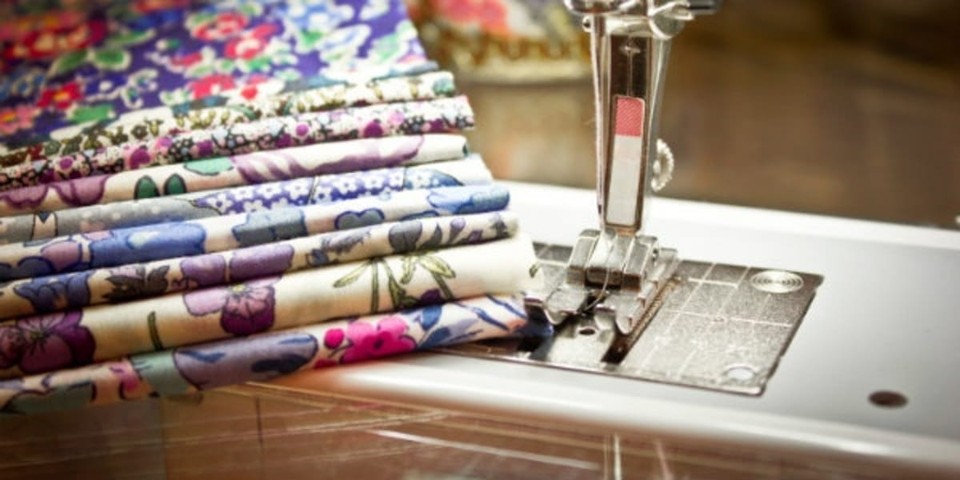Is There a Point to Homeschool Home Ec?

Why I picked the octopus pillow for my seventh-grade home economics project, I will never know. I guess I thought it was cute, and I chose it not realizing the curves of the legs and body would make it a more difficult sewing project than some of the other options.
I found the sewing very difficult, and to add insult to injury, I, the straight-A student, received a B on my rather angular octopus. This first experience on a sewing machine so traumatized me that I decided it would be my last project on a sewing machine, and I hardly touched a sewing machine for most of my early adulthood.
Twenty-four years after my junior high sewing experience, I was sitting at camp with a group of homeschooled families. Downstairs, one family was giving a demonstration on how to make a tiered skirt without a pattern. Later, we heard from a young teenaged girl who had her own business selling custom totes and aprons she made herself. When this girl was 9, she sewed all the clothing worn by the bridal party in her sister’s wedding. At this time, I did not even own a sewing machine. But these lovely families planted a vision in my heart to make my home a place of productivity, not just for myself, but so I could pass these skills on to my daughters.
I could have found lessons and classes for my daughters to attend that would teach them the homemaking skills I lacked, but this was an area I felt God was leading me to tackle for myself. I knew my daughters would be more interested in learning if I led by example. I also wanted to learn because I had always felt a little crippled by my lack of homemaking skills. It was frustrating to not be able to efficiently mend a tear in a seam or hem a pair of pants. I wanted the freedom homemaking skills would give me to be more of a do-it-yourselfer. From families like those I observed at camp, I also began to see that homemaking skills could really enrich a home by equipping a mom to be creative and industrious.
Now I had the vision to learn, but I was 37 years old and had two children under 2. Since I was needed at home and couldn’t attend formal classes on a regular basis, I set out to find ways to learn sewing, knitting, and crocheting on my own. With God’s blessings, I learned all three skills in one year and now make clothes for my children and crochet Christmas gifts.
Here are a few of the resources God led me to while I was setting up my homeschool home economics course.
My first step in learning how to sew was acquiring a sewing machine. Originally, I purchased my sewing machine online, but my online shopping experience was not a good one. I don’t know if the machine arrived broken or if my incompetence quickly broke it, but I never sewed a seam with that machine. For my next attempt, I went to a small sewing machine store in town. A nice saleslady helped me select a beginner machine that had the quality of more expensive machines, but not the bells and whistles. She spent half an hour letting me try out the machine and sew some seams, and she signed me up for a free “Get to Know Your Sewing Machine” class that was offered at the store. The sewing machine I bought from the sewing store was three times the cost of the machine I bought online, and it was worth every penny.
Next, I selected a sewing curriculum. The book that worked well for me was Sew Fast, Sew Easy by Elissa K. Meyrich. The author teaches a sewing school in New York City, and when she could not find a textbook she liked, she decided to write her own. The book comes with patterns to complete three projects: a pillow, a tote bag, and a skirt. Detailed step-by-step instructions are given about how to purchase supplies and how to read a pattern. The author does a good job of assuming the reader knows nothing, as was definitely true of me! When I had worked my way through the book, I was competent enough to read a simple pajama pattern I purchased from the fabric store.
If you can spare the time, many fabric stores offer sewing classes. I was able to take a beginners’ class and met a wonderful master seamstress named Ann who cheered me on through a couple of projects. But I found that after completing Sew Fast, Sew Easy, I could have completed those beginner projects on my own—so don’t feel you must take a class in order to begin sewing.
After my sewing skills began to develop, I wanted to expand and learn some handwork skills. I particularly wanted to tackle knitting and crocheting. I once read an article by Janet Hulcy of KONOS curriculum in which she encouraged adults who wanted to learn something new to go to the children’s section of the library. Adult books always seem to assume the reader has a certain base of knowledge, whereas children’s books teach the basics. My 12-year-old niece had taught herself to knit using a “learn to knit” book by Klutz. I purchased both the Klutz knitting book and the Klutz crocheting book and successfully learned the basics of both skills. One of nice features of Klutz books is that they come with all the supplies required to complete several projects. The yarn aisle at the craft store can be mighty intimidating and expensive to someone just learning, so it was very helpful to have the correct supplies already purchased for me. These books also contain a guide to help the reader purchase additional supplies when needed. The colorful, detailed, step-by-step instructions in these books helped me begin knitting and crocheting after only a couple of hours’ practice.
Knitting and crocheting are wonderful skills. Unlike a sewing machine, yarn, needles, and hooks are portable and can go anywhere. I find taking a useless piece of yarn and turning it into something beautiful and functional very satisfying. I continue to follow Janet Hulcy’s sage advice and look for patterns written for young knitters and crotcheters. I’m slowly learning to read a pattern, and I’m currently creating granny-square scarves for potential Christmas gifts.
I’ve been amazed at how much these new skills have added to our family life. We have a lot of fun choosing fabrics and patterns for our projects. One of my daughters loves monkeys and another loves horses, and it’s been gratifying to make them outfits out of monkey and horse motif cloth. While some may argue that it’s often more cost-effective to buy clothes ready-made than to sew them, I could not have purchased these special outfits for any price. It’s also very freeing knowing we can make for ourselves the clothes we like to wear even when those types of clothes are not in style and so are not available in the store.
My daughters, as I had envisioned, are starting to pick up these skills for themselves. In our entertainment-driven culture, it’s wonderful to see them choosing to use their free time to do something productive.
I’ve used many of the same resources to teach my children that I used to teach myself. The sewing books by JoAnn Gagnon have also been very helpful. Her book Catching the Sewing Bug is full of simple projects for beginning seamstresses and can be used with children as young as 4. As I began to teach my own children homemaking skills, I started having opportunities to teach other children and teenagers as well. It’s been my observation that girls are anxious to learn these creative skills, but many moms are ill-equipped to teach because they never learned these skills themselves. I never imagined when I was out purchasing my sewing machine that it would open up chances to minister and be a blessing to other families.
I think there’s something good for the soul about working with one’s hands. The Bible backs that up, and in one of many passages describing the importance of industry, the virtuous woman is described as one who “works willingly with her hands” (Proverbs 31:13). Teri Maxwell of Titus 2 Ministries once said she enjoys sewing because it’s something she does that “stays done.” Most of the tasks a mother tackles, such as cooking, washing dishes, and doing the laundry, must be done over and over again. It’s rewarding to complete sewing or crocheting projects that don’t have to been done over in short order. My girls and I have also found we enjoy the creativity and productivity so much that we’re excited to learn other skills, such as cake decorating, embroidery, and quilting. The rewards to both my family and myself have made the effort required to create our homeschool home economics course infinitely worthwhile.
Cindy Puhekresides in Colorado Springs where she spends her time working as a help meet to her beloved husband and training her 5 children to be warriors for Jesus. Cindy earned a masters degree in chemistry and had a career teaching science classes before realizing God’s highest call on her life is to invest her gifts and talents to make her home a place of ministry and industry and refuge. You can visit Cindy’s blog at www.hseblogs.com/cindy.
This article was originally published in the Mar/Apr 2011 issue of HomeSchoolEnrichment Magazine. To learn more, and to request a FREE sample copy, visit www.HomeSchoolEnrichment.com
Originally published July 27, 2018.





